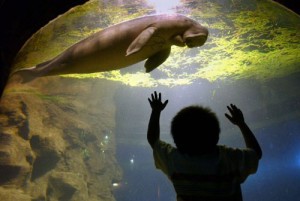New book says 2 PH marine mammals on verge of extinction
MANILA, Philippines—Local populations of dugong and Irrawaddy dolphin are on the verge of extinction, according to a new book released this month detailing the conservation status of marine mammals found in the Philippines.
The book, titled “Red List Status of Marine Mammals,” assesses the status of 26 out of 28 marine mammal species and subspecies found in the Philippines, according to a news release from the Department of Environment and Natural Resources.
Scientists found that two of the species assessed were critically endangered: the dugong, with scientific name Dugong dugong, whose remnant populations are found in Philippine coastal waters, and an isolated population of the Irrawaddy dolphin, or Orcaella brevirostris, in the Malampaya Sound, Palawan.
Animals categorized as critically endangered face an extremely high risk of extinction in the wild.
Released this month, the publication is “the most comprehensive and up-to-date list of the country’s threatened dolphins, whales and dugong,” the DENR said.
Article continues after this advertisementAccording to the book, local populations of dugong and Irrawaddy dolphin are declining despite legislation and conservation efforts.
Article continues after this advertisement“They continue to face threats such as destruction of habitat, entanglement in fishing nets, solid wastes, coastal development, boat traffic, and sedimentation, all made more severe with climate change impacts,” it said.
In addition to the two species, 24 other marine mammals found in the Philippines were assessed by at least 20 scientists, experts, researchers and conservation managers based on the Red List categories and criteria set by the International Union for the Conservation of Nature (IUCN).
They analyzed the best available information on threats to the species and habitat, population estimates, and rates of population reduction, among others. Marine mammals are one of the few taxonomic groups assessed using the IUCN categories at a regional/national level.
“[This] book is an excellent account of research work on the ecology, distribution, threats, and conservation status of Philippine marine mammals,” former Environment Secretary Angel Alcala, a marine biologist and Ramon Magsaysay laureate, wrote in his foreword.
The book contains texts, photos, maps, and illustrations providing relevant government agencies, non-governmental organizations, advocacy groups, and even individuals with science-based information that may influence policy decisions and actions toward reversing, or at least halting, the decline in Philippine marine biodiversity.
Results of the national marine mammal Red List assessment categorized four other marine mammal species in the Philippines as “vulnerable”:
the humpback whale, Fraser’s dolphin, Gray’s spinner dolphin, and the sperm whale.
Another alarming result of the Red List Status is that 20 of the 24 species and subspecies assessed are “data deficient,” meaning there has not been adequate research on their condition, threats, and capacity for survival, according to the book.
“This does not mean that these animals are out of the ‘red’ and not threatened. It just shows that there is an urgent need for more research,” said Dr. AA Yaptinchay, director of Marine Wildlife Watch of the Philippines, and one of the researchers.
Studies on these species are necessary for conservation planning, policy making on local and international levels, and monitoring trends in extinction and tracking of progress towards conservation of the remaining populations, the DENR said.
“It is hoped that other threatened animal and plant groups, both terrestrial and marine, will be assessed at the national level as variations in their status are expected based on the geographical distribution of each species and the different levels of threats that these populations or sub-populations are exposed to,” it added.
For example, an IUCN-assessed species such as a dugong is considered “vulnerable” globally but the population in the Philippines is “critically endangered.”
“Hopefully, this publication will encourage our nation to provide the extra effort to ensure the protection of these threatened animals as well as their habitats,” Yaptinchay said.
“Perhaps in the next assessment, we will see an improvement on their status. It will be very sad if their status becomes worse, because extinction is the only step left after a ‘critically endangered’ listing,” he added.
